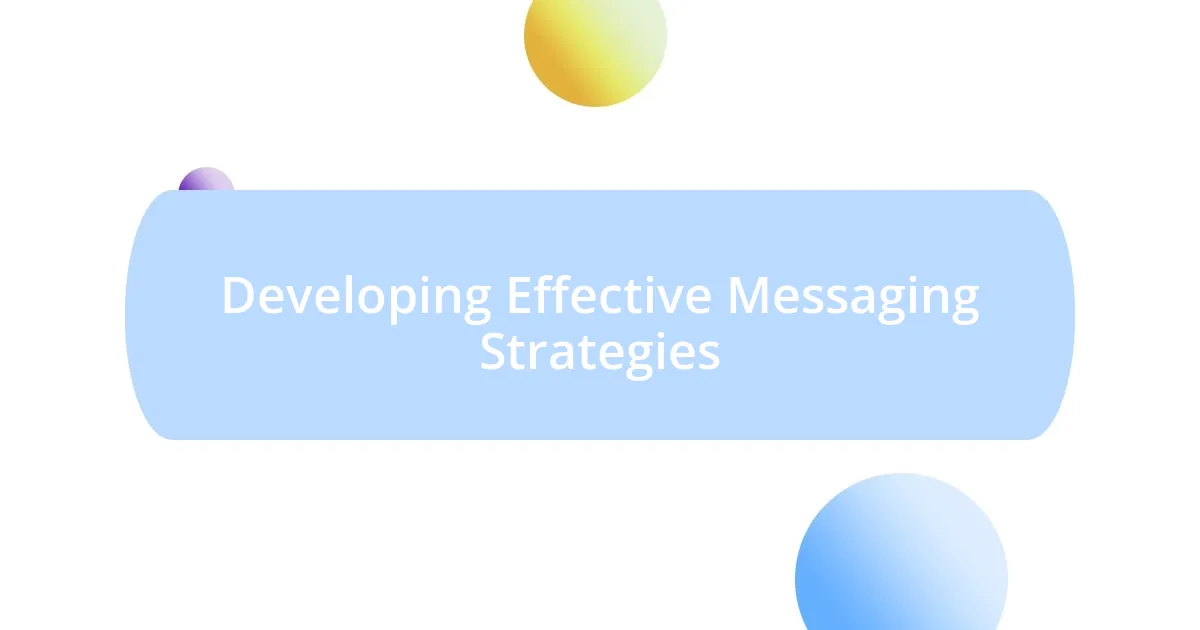Key takeaways:
- Effective advocacy merges knowledge with strategic communication to inspire action and dialogue.
- Identifying diverse stakeholders enhances credibility and fosters inclusive advocacy efforts.
- Data visualization and storytelling are powerful tools for engaging audiences and driving home the impact of advocacy.
- Evaluating outcomes involves analyzing both quantitative metrics and personal stories to assess long-term community change.

Understanding Policy Advocacy Fundamentals
Policy advocacy is the bridge between understanding a problem and effecting change. I remember my first encounter with advocacy during a local community meeting where passionate voices united for a cause. It struck me then how a clear understanding of the issues at play is crucial; without it, advocacy can feel aimless and disconnected from reality.
Effective advocacy requires not just knowledge but also strategic communication. I once spent hours drafting a policy brief, only to have peers remind me that clarity was key. This experience taught me to always ask: How can my message resonate? The goal isn’t just to inform; it’s to inspire action and create a dialogue that captures people’s hearts and minds.
Building relationships is fundamental in the realm of policy advocacy. I’ve found that genuine connections often spark the most effective collaborations. A colleague once shared with me that reaching out for coffee with a local policymaker opened doors that formal meetings never could. This revelation made me realize: how do we nurture our networks to amplify our voices in the policy arena?

Identifying Key Stakeholders
Identifying key stakeholders is crucial for any successful policy advocacy effort. I remember when I was part of a campaign that aimed to improve local environmental regulations. At first, we assumed that engaging solely with government officials would be sufficient. However, as we progressed, I realized the importance of including diverse voices—community groups, businesses, and even youth organizations—who were directly impacted by environmental issues. This broadened our perspective and enhanced our credibility.
To effectively identify key stakeholders, consider the following factors:
– Influence: Who holds power in this area?
– Interest: Which groups are affected by the policy?
– Expertise: Who possesses knowledge that can inform our approach?
– Resources: Who has the capability, like funding or connections, to support your advocacy?
The more comprehensive your stakeholder map, the more robust your advocacy strategy will be. Establishing these connections has led me to some of the most rewarding conversations and collaborations in my advocacy journey.

Developing Effective Messaging Strategies
Developing effective messaging strategies is essential for driving home the impact of your advocacy. I’ve seen firsthand how a well-crafted message can turn the tide on public opinion. During one campaign, our team simplified complex topics into relatable stories, making the message accessible to everyone. Seeing community members unite over shared experiences was nothing short of magical—it reinforced my belief that storytelling is a powerful vehicle for change.
Clarity and consistency are crucial when creating your message. I remember drafting a message for a health policy initiative, and after multiple revisions, the simplicity of our core intention shone through. The clearer our objective became, the more we found ourselves resonating with varied audiences. It’s interesting how omitting jargon can open doors to engagement we hadn’t previously considered.
Additionally, testing your message with target audiences can yield surprising insights. I once conducted informal focus groups, and the feedback was invaluable—a turning point, really. Those conversations helped me refine our approach, making our communications not just effective, but genuinely relatable. What I learned is that engaging with your audience is not merely beneficial; it’s essential for successful advocacy.
| Messaging Strategy | Description |
|---|---|
| Storytelling | Using relatable stories to connect emotionally with your audience. |
| Clarity and Consistency | Simplifying complex issues to ensure understanding and a unified message. |
| Audience Testing | Gathering feedback from your target audience to refine your messaging approach. |

Leveraging Coalitions and Partnerships
When it comes to leveraging coalitions and partnerships, I’ve often found that relationships can amplify our voice significantly. A few years back, I collaborated with a nonprofit focused on health equity. We joined forces with local businesses and schools, which transformed our advocacy efforts. It was one of those moments where I realized that partnerships not only widen our reach but also inspire a sense of shared purpose. Have you ever experienced that kind of synergy? It can be exhilarating!
Building trust within a coalition is crucial. I remember organizing a meeting with diverse stakeholders where tensions ran high due to differing priorities. I chose to lay the groundwork by facilitating open dialogue, and to my surprise, people began to share their stories of why they cared about the issue. That candid sharing fostered understanding and unity, showing me the power of empathy in coalition-building. It’s those authentic conversations that can turn a group of individuals into a powerful collective.
Partnerships also bring unique resources to the table. During another initiative, a coalition partner offered us access to their extensive data on community health trends. This insight shaped our argument and made it more persuasive. Have you thought about the unexplored resources your partners might hold? Engaging in these partnerships can unveil opportunities that would otherwise remain hidden, driving our advocacy efforts forward.

Employing Research and Data
I’ve learned that employing research and data is the backbone of effective policy advocacy. When we dove into statistical analyses for a recent environmental initiative, I noticed how numbers could evoke emotions just as strongly as a heartfelt story. Sharing data that showed a tangible impact on our community made the issue urgent and personal. Have you ever felt the weight of statistics driving home a message? It’s incredible how a graph can become a rallying cry for action.
In my experience, the right data can create unexpected connections. I remember participating in a town hall meeting where we presented carefully curated research on air quality, and I watched as skeptical community members leaned in closer. This transformation was a powerful reminder of how data can serve as a common ground. People began to see the issue in a new light, and the room buzzed with discussion about potential solutions. Have you ever caught someone’s attention just by presenting compelling facts? It’s a game changer.
Moreover, I’ve found that visualizing data in engaging ways can significantly enhance your advocacy message. During another campaign, we created infographics that simplified complex research findings. It was rewarding to see how these visuals sparked conversations and even social media shares. I often ask myself: how can we present our data in a way that invites curiosity rather than confusion? Finding that balance is key, and it’s something I continuously strive for in my advocacy work.

Engaging in Grassroots Mobilization
Engaging in grassroots mobilization requires a deep understanding of your community’s needs and interests. One impactful moment for me was when I spent a Saturday morning door-knocking in my neighborhood, talking to residents about their concerns regarding public transportation. It was eye-opening to hear firsthand how these issues affected their daily lives. Have you ever truly listened to your community in action? Those conversations sparked a wave of enthusiasm and led to a rally that united voices behind our shared struggle.
The power of grassroots mobilization lies in building a network of passionate individuals. I recall organizing a small gathering with local activists, where we collectively brainstormed strategies to raise awareness about a pressing issue. The energy in that room was palpable as ideas flowed freely, and that sense of camaraderie ignited a determination to take action. When was the last time you collaborated with others who share your passion? There’s something extraordinary about pooling resources and talents that turns an idea into a movement.
Moreover, leveraging social media to amplify grassroots efforts has proven invaluable in my experience. During a campaign to save our local park, we created a Facebook group that not only shared information but also encouraged neighbors to share their own stories. I was amazed at how quickly our small group grew and galvanized support. Have you utilized online platforms to reach wider audiences? It’s fascinating to see how digital engagement translates into real-world action and fosters a community spirit that can lead to significant change.

Evaluating Advocacy Outcomes and Impact
Evaluating advocacy outcomes and impact is critical for understanding our effectiveness and the paths we can take for improvement. I remember a time when we analyzed the results of a campaign to increase funding for local education. We gathered feedback through surveys, and what struck me was how many parents felt heard and valued from our efforts. Have you ever experienced a moment where data confirmed your intuition? It can be a powerful affirmation.
Another vivid experience was during a debrief meeting after a successful campaign. We discussed not just the numbers—like increased funding—but also the personal stories shared by the community. Those narratives painted a clearer picture of our impact, creating a heartfelt connection among team members. Isn’t it interesting how numbers can come alive through the voices of the people we aim to serve? Reflecting on those stories gave our advocacy renewed purpose.
Moreover, I’ve realized that evaluating outcomes isn’t merely about metrics; it’s also about understanding the long-term changes we’ve seeded in our community. After our environmental initiative, we saw a rise in community-driven clean-ups, driven by those initial conversations and data presentations we held. I often ponder: what legacy are we leaving with our advocacy? It’s crucial to look beyond immediate results and focus on sustainable change that empowers individuals to continue the work long after we’ve moved on.














